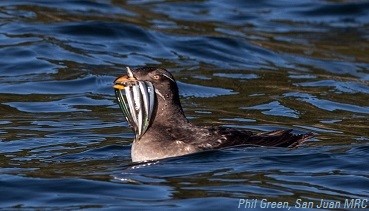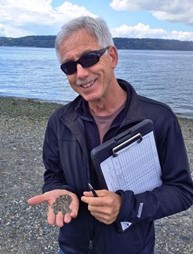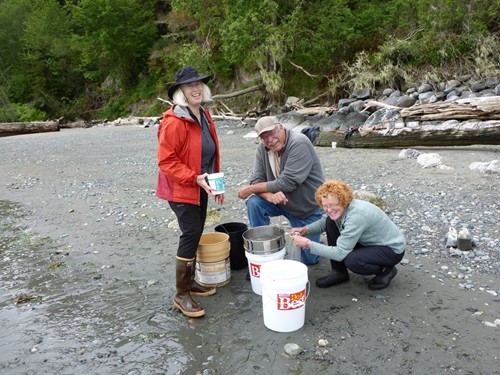Forage Fish
Overview
 Forage fish have long been a focus of our work, and there is no one simple approach to protecting them. Clean water and availability of zooplankton and other food is important. Herring lay their eggs on kelp, eelgrass and other substrates. Sand lance and surf smelt lay their eggs on the beach, where survival is tricky. We need to preserve these vulnerable habitats.
Forage fish have long been a focus of our work, and there is no one simple approach to protecting them. Clean water and availability of zooplankton and other food is important. Herring lay their eggs on kelp, eelgrass and other substrates. Sand lance and surf smelt lay their eggs on the beach, where survival is tricky. We need to preserve these vulnerable habitats.
The MRCs have surveyed and mapped spawning beaches in seven counties, providing many years of data to local governments and resources managers. Our scientific workshops and symposia have spurred new collaborations among forage fish experts in the US and Canada.
WHAT WE’RE DOING
 The Commission provides core funding and technical support for monitoring to inform research, policy, and local planning efforts; as well as targeted outreach by the MRCs to reduce stressors on forage fish populations (i.e. shoreline armoring, stormwater runoff into local embayments).
The Commission provides core funding and technical support for monitoring to inform research, policy, and local planning efforts; as well as targeted outreach by the MRCs to reduce stressors on forage fish populations (i.e. shoreline armoring, stormwater runoff into local embayments).
Commission staff helped start the PSEMP Forage Fish and Food Webs Work Group, and continues to provide staff support and participate in the group. This group of technical experts has bolstered commitments to strengthen monitoring needed for Puget Sound recovery.
HOW WE’RE DOING IT
 The Commission holds forage fish survey workshops to train citizen science volunteers to document spawning activity by surf smelt and sand lance. Since 2014, we have trained more than 100 volunteers at training events hosted in collaboration with the Washington Department of Fish and Wildlife. Volunteers are surveying beaches in all seven Northwest Straits counties and sharing their data with state agencies and local governments.
The Commission holds forage fish survey workshops to train citizen science volunteers to document spawning activity by surf smelt and sand lance. Since 2014, we have trained more than 100 volunteers at training events hosted in collaboration with the Washington Department of Fish and Wildlife. Volunteers are surveying beaches in all seven Northwest Straits counties and sharing their data with state agencies and local governments.
Click here to view training materials and presentations from our Forage Fish Sampling Training.
-
Cornet Bay Restoration
Island MRC partnered to restore 1,000 feet of shoreline, improving spawning habitat for forage fish and nearshore habitat for salmon and forage fish.
View the Project Details »
-
Fort Townsend Nearshore Restoration
Jefferson MRC, NW Straits Foundation & partners removed 1,700 cubic yards of fill and rip rap to improve habitat for forage fish & other species.
View the Project Details »
-
Nearshore Restoration
Snohomish MRC completed work at four sites, restoring 0.85 miles of shoreline and 2.4 acres of habitat that will benefit forage fish.
View the Project Details »
-
Bowman Bay Restoration
Skagit MRC, NW Straits Foundation and partners removed over 540 feet of armoring, improving 0.6 acres of habitat for forage fish.
View the Project Details »